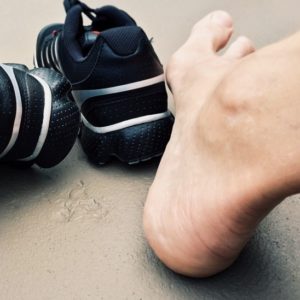 Nearly eight out of 10 Americans have experienced significant foot pain at some point; one out of five report suffering from foot pain daily; half of all adults say foot pain has restricted their activities such as walking, exercising or even just standing; and those who suffer from chronic foot pain are significantly more likely to have pain in other parts of their body, i.e. back, knee, joint and nerve pain.
Nearly eight out of 10 Americans have experienced significant foot pain at some point; one out of five report suffering from foot pain daily; half of all adults say foot pain has restricted their activities such as walking, exercising or even just standing; and those who suffer from chronic foot pain are significantly more likely to have pain in other parts of their body, i.e. back, knee, joint and nerve pain.
The most common cause of heel pain is plantar fasciitis. Usually this is an easy diagnosis based on the history of symptoms and clinical exam, but sometimes other imaging such as X-rays, ultrasound and MRI can be helpful to rule out other causes of heel pain such as stress fractures.
The plantar fascia is a thick band of connective tissue that acts like a ligament to help support your arch and provide shock absorption during weight bearing activities. The area where the plantar fascia attaches to the bottom of the heel bone is a place that can get stressed or injured and become inflamed. When this happens, you have plantar fasciitis. The good news is that this is not a dangerous condition, i.e. it won’t lead to any other conditions or create a bigger problem. The bad news is that this can really hurt and become limiting. Active men and women between the ages of 40 and 70 are at the highest risk of developing plantar fasciitis. It is slightly more common in women than men. Approximately 80 percent of cases will resolve within six months, but that is still a long time to live with heel pain!
Unfortunately, the classic old-school thinking on plantar fasciitis has been propagated through older podiatric and medical channels, as well as through information gleaned from the internet. The concepts that plantar fasciitis comes from a heel spur, that your shoes caused it, that walking on concrete created this problem, that a $400-pair of custom arch supports will cure it, or that steroid injections are the standard of care, are all misinformation and have never been scientifically proven.
There are endless treatments out there for plantar fasciitis that are, for the most part, easy and don’t cause harm, so I’m in favor of hitting it from multiple angles. However, the bottom line is that the only true cure for this problem involves exercise for your foot.
Foot exercises involve things ranging from scrunching a towel with your toes to balancing on a soft, unstable surface with one foot while performing other movements. Anything that challenges the muscles in your foot will contribute to the cure. A great option is jumping rope for an accumulation of six minutes a day (providing you can do this safely and feel comfortable with this form of exercise). In my opinion, the worst thing you can do for plantar fasciitis is to become sedentary.
I see many people in my practice who have been dealing with heel pain for longer than six months, and for them, there are some other options to consider as well:
- Physical therapy/personal training: Guidance through specific exercises for the foot sometimes is what we need to really stay motivated and stay on top of the routine. There’s nothing wrong with relying on the expertise of someone else to help you get strong!
- Alternative/manipulative therapies: Myofascial release, deep massage, acupuncture and acupressure are all harmless and easy alternative therapies that may have some benefit.
- Splints, bracing, orthotics: Night splints that hold the foot and ankle in an upward stretched position can really help with the painful morning symptoms. A simple off-the-shelf arch support can relieve symptoms during the day or during exercise. Don’t feel the need to spend more than $50 on an arch support, there’s nothing magical about a “custom-fitted” orthotic for this problem.
- Steroid Injections: I usually offer only one of these if a person’s pain is severe and has not responded to other standard treatments. In general, don’t do more than one steroid injection in this location, as the steroid may have a softening effect on your heel padding when it’s given multiple times.
- Regenerative injections: New biologic and cellular injections are becoming a popular alternative form of treatment. These involve injecting either a person’s own cells or cells and proteins taken from another source such as frozen cells from umbilical cord tissue. The theory is that these cells have a greater potential for stimulating healing than the injured tissue within the body. Although larger well-controlled studies have yet to show dramatic changes in healing, there is a growing body of smaller studies showing success with these types of injections for all kinds of soft tissue and joint related problems.
One of the most successful biologic treatment options is Platelet Rich Plasma (PRP) Therapy, which isolates the specific cells from your own blood that can augment or improve the healing process when injected for plantar fasciitis. Consider this in addition to my standard recommendations, especially if your heel pain is keeping you from enjoying the beautiful spring weather here in Flagstaff! FBN
By Stephen Knecht, MD
Dr. Stephen Knecht is a fellowship-trained orthopaedic surgeon specializing in foot and ankle care. He practices at the Foot and Ankle Center at Northern Arizona Orthopaedics (NAO), inside the Summit Center. PRP and alternative therapies are currently being offered in each NAO Specialty Center for a variety of conditions. To learn more or to schedule an appointment, call 928-774-7757 or visit NorthAZortho.com.





